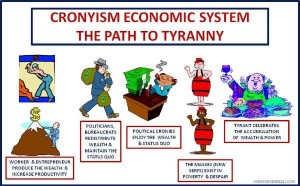If people are criticizing the Federal Reserve, it’s overwhelmingly likely that they are focused on the central bank’s poor conduct of monetary policy.
And there’s plenty to criticize, as documented in this video featuring Professor George Selgin.
I also have a video, explaining how central banks arose and noting that private markets were responsible for money in the past and could fulfill that role in the future (John Stossel also has weighed in on that topic)
It’s important to understand, however, that the Fed’s powers – and its ability to cause mischief – are not limited to monetary policy.
Let’s look at some excerpts from a Wall Street Journal column by John Cochrane, a Cato adjunct scholar and professor at the University of Chicago. We’ll start with a look at the expanded powers of the Federal Reserve.
We are used to thinking that central banks’ main task is to guide the economy by setting interest rates. …Since the 2008 financial crisis, however, the Federal Reserve has intervened in a wide variety of markets, including commercial paper, mortgages and long-term Treasury debt. At the height of the crisis, the Fed lent directly to teetering nonbank institutions, such as insurance giant AIG, and participated in several shotgun marriages, most notably between Bank of America and Merrill Lynch. …Many Fed officials, including Fed Chairman Ben Bernanke, see “credit constraints” and “segmented markets” throughout the economy, which the Fed’s standard tools don’t address. …In his speech Friday in Jackson Hole, Wyo., Mr. Bernanke made it clear that “we should not rule out the further use of such [nontraditional] policies if economic conditions warrant.”
But are these developments good or bad? Professor Cochrane is worried.
…the Fed has crossed a bright line. …an agency that allocates credit to specific markets and institutions, or buys assets that expose taxpayers to risks, cannot stay independent of elected, and accountable, officials. In addition, the Fed is now a gargantuan financial regulator. Its inspectors examine too-big-to-fail banks, come up with creative “stress tests” for them to pass, and haggle over thousands of pages of regulation.
And he provides an example of what happens when the Fed no longer is bound by the rule of law.
A revealing example of where we are going emerged last spring, admirably documented on the Fed’s website. Using its bank-regulation authority, the Fed declared that the banks that had robo-signed foreclosure documents were guilty of “unsafe and unsound processes and practices”—though robo-signing has nothing to do with the banks taking too much risk. The Fed then commanded that the banks provide $25 billion in “mortgage relief,” a simple transfer from bank shareholders to mortgage borrowers—though none of these borrowers was a victim of robo-signing. The Fed even commanded that the banks give money to “nonprofit housing counseling organizations, approved by the U.S. Department of Housing and Urban Development.” …you can see where we are going: Hey, nice bank you’ve got there. It would be a shame if the Consumer Financial Protection Bureau decided your credit cards were “abusive,” or if tomorrow’s “stress test” didn’t look so good for you. You know, we’ve really hoped you would lend more to support construction in the depressed parts of your home state.
 This is both outrageous and worrisome. It’s outrageous because there is no legal authority for this form of coerced redistribution. But it’s worrisome because the Fed is seeking to things that should be well outside its mandate, such as dictating the actions of the financial sector and engaging in cronyism.
This is both outrageous and worrisome. It’s outrageous because there is no legal authority for this form of coerced redistribution. But it’s worrisome because the Fed is seeking to things that should be well outside its mandate, such as dictating the actions of the financial sector and engaging in cronyism.
This doesn’t mean we’re suddenly as corrupt and inefficient as Argentina, but it does mean that we’re drifting in that direction. And don’t think it’s impossible. Argentina used to be a rich nation before the statists took control.
We’re already making similar mistakes in other areas, as evidenced by the green energy scam. Now it’s happening with the Fed. Next thing you know, you’ll wake up one day speaking Greek, Italian, or Spanish.
P.S. Shifting back to monetary policy, here’s Julie Borowski’s Fed-bashing video (she also narrated this video on the third-party payer problem), and here’s the famous “Ben Bernank” video.

